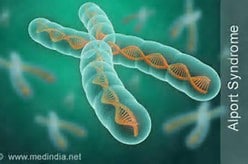The next in our series of syndromes that hearing loss may help identify is Alport Syndrome. The areas that are affected most in Alport are kidney disease, hearing loss, and eye abnormalities. Kidney disease in of itself is linked to hearing loss as described in an earlier post, but those with Alport syndrome have a progressive loss of kidney function to the point of End-stage kidney disease, which requires dialysis.
The eye abnormalities include misshapen lenses in the eyes and coloration differences in the retina. Despite these abnormalities, vision loss is rarely associated with Alport syndrome. Hearing loss, though, is frequent with this syndrome. As the child grows, the inner ear develops abnormalities and progressive sensorineural hearing loss occurs.
The presence of Alport syndrome is about 1 in 50,000 newborns, with males having more severe symptoms. The syndrome is x-linked about 80% of the time, meaning that the affected gene is on the X chromosome. Since males only have one X chromosome, this causes their symptoms to be more severe. Close to 15% of the time the syndrome is passed in an autosomal recessive pattern, with each parent having a copy passed onto the child. As in Jervell Lange, and many other syndromes of autosomal recessive, the carriers may not show symptoms or are completely unaffected.
The recommended testing for diagnosing Alport syndrome is hearing evaluation, creatinine (protein in urine) and BUN (bluood urea nitrogen) testing, blood count, renal biopsy and urinalysis. Once Alport is diagnosed there is no cure, but treatment includes monitoring and treating to control the disease.
Here are some resources for those wanting more information on Alport Syndrome, snd patient support centers.
If you or someone you know would like to find a genetic professional in your area, here is a good place to start.






